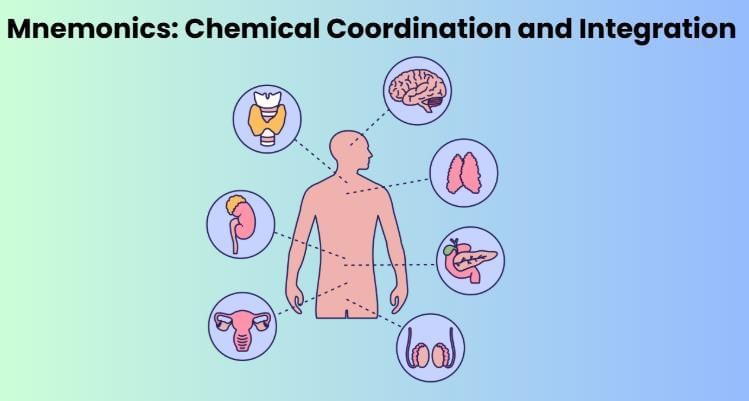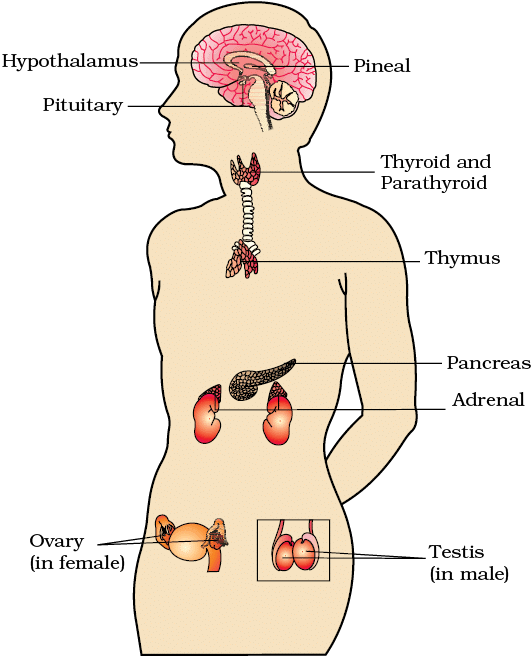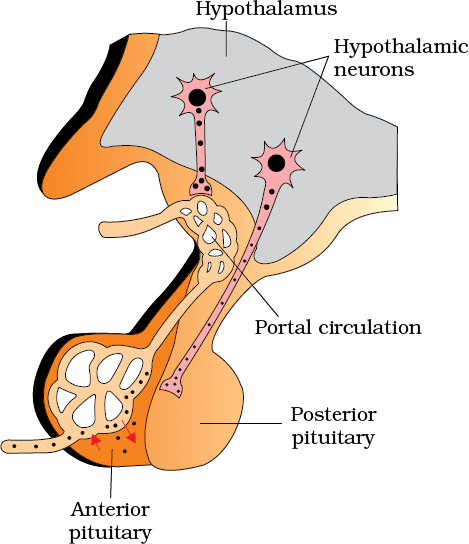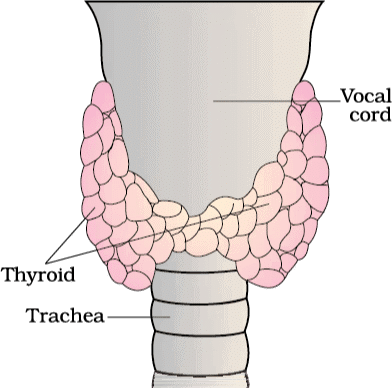Mnemonics: Chemical Coordination and Integration | Biology Class 11 - NEET PDF Download
This document will help you remember important information about Chemical Coordination and Integration in a fun and simple way. Inside, you’ll find mnemonics—easy memory tricks—that will make it easier to recall key concepts, hormone names, gland functions, and related examples.

Whether you’re studying for an exam, preparing for a quiz, or just aiming to strengthen your understanding of this topic, these mnemonics will act as handy learning tools. Use them alongside your regular study routine to reinforce your knowledge and improve recall.
Happy mnemonic learning!
1. Major Endocrine Glands
Glands: Hypothalamus, Pituitary, Pineal, Thyroid, Parathyroid, Thymus, Adrenal, Pancreas, Testis, Ovary
Mnemonic: "Happy People Play Together, Party Till All Pets Take Off"
Breakdown:
Happy → Hypothalamus
People → Pituitary
Play → Pineal
Together → Thyroid
Party → Parathyroid
Till → Thymus
All → Adrenal
Pets → Pancreas
Take → Testis
Off → Ovary
 Location of endocrine glands
Location of endocrine glands
2. Hormones of Anterior Pituitary (Pars Distalis)
Hormones: Growth Hormone (GH), Prolactin (PRL), Thyroid Stimulating Hormone (TSH), Adrenocorticotropic Hormone (ACTH), Luteinizing Hormone (LH), Follicle Stimulating Hormone (FSH)
Mnemonic: "Great Parents Teach Amazing Life Facts"
Breakdown:
- Great → Growth Hormone (GH)
- Parents → Prolactin (PRL)
- Teach → Thyroid Stimulating Hormone (TSH)
- Amazing → Adrenocorticotrophic Hormone (ACTH)
- Life → Luteinizing Hormone (LH)
- Facts → Follicle Stimulating Hormone (FSH)
 Diagrammatic representation of pituitary and its relationship with hypothalamus
Diagrammatic representation of pituitary and its relationship with hypothalamus
3. Hormone of Anterior Pituitary (Pars Intermedia)
Hormone: Melanocyte Stimulating Hormone (MSH)
Mnemonic: "Makes skin healthy"
Breakdown:
- Make → Melanocyte Stimulating Hormone
- Skin Healthy → Role in pigmentation
4. Hormones of the Posterior Pituitary
Hormones: Oxytocin, Vasopressin (ADH)
Mnemonic: "Open Valves"
Breakdown:
- Open → Oxytocin
- Valves → Vasopressin (Antidiuretic Hormone, ADH)
5. Hormones of the Thyroid Gland
Hormones: Thyroxine (T4), Triiodothyronine (T3), Thyrocalcitonin (TCT)
Mnemonic: "Two T’s Control"
Breakdown:
- Two → Thyroxine (T4)
- T’s → Triiodothyronine (T3)
- Control → Thyrocalcitonin (TCT)
 Thyroid gland - Ventral Side
Thyroid gland - Ventral Side
6. Hormones of the Adrenal Medulla
Hormones: Adrenaline (Epinephrine), Noradrenaline (Norepinephrine), together called catecholamines ( responsible for the Fight/Flight Action)
Mnemonic: "Always Nervous"
Breakdown:
- Always → Adrenaline (Epinephrine)
- Nervous→ Noradrenaline (Norepinephrine)
 Diagrammatic representation of : (a) Adrenal gland above kidney (b) Section showing two parts of adrenal gland
Diagrammatic representation of : (a) Adrenal gland above kidney (b) Section showing two parts of adrenal gland
7. Hormones of the Adrenal Cortex
Hormones: Glucocorticoids (e.g., Cortisol), Mineralocorticoids (e.g., Aldosterone), and Androgenic Steroids
Mnemonic: "Good Men Achieve"
Breakdown:
- Good→ Glucocorticoids (e.g., Cortisol)
- Men → Mineralocorticoids (e.g., Aldosterone)
- Achieve → Androgenic Steroids
8. Hormones of Pancreas (Islets of Langerhans)
Hormones: Glucagon, Insulin
Mnemonic: "Go Inside"
Breakdown:
- Go → Glucagon (secreted by alpha cells, increases the Glucose level in blood )
- Inside → Insulin (secreted by beta cells, decreases glucose level in blood)
9. Hormones of Heart, Kidney, and Gastrointestinal Tract
Hormones: Atrial Natriuretic Factor (ANF, Heart), Erythropoietin (Kidney), Gastrin, Secretin, Cholecystokinin (CCK), Gastric Inhibitory Peptide (GIP) (Gastrointestinal Tract)
Mnemonic: "All Elephants Gas, Secrete Carry Gifts"
Breakdown:
- All → Atrial Natriuretic Factor (ANF)
- Elephants→ Erythropoietin
- Gas → Gastrin
- Secrete→ Secretin
- Carry → Cholecystokinin (CCK)
- Gifts → Gastric Inhibitory Peptide (GIP)
10. Disorders Due to Hypo- and Hypersecretion of Hormones by Various Glands
Disorders:
Hypothalamus/Pituitary (GH): Dwarfism (Hypo), Gigantism/Acromegaly (Hyper)
Thyroid (T4/T3): Cretinism/Goitre (Hypo), Exophthalmic Goitre (Hyper)
Parathyroid (PTH): Hypocalcemia (Hypo), Hypercalcemia (Hyper)
Adrenal Cortex: Addison’s Disease (Hypo), Cushing’s Syndrome (Hyper)
Pancreas (Insulin): Diabetes Mellitus (Hypo)
Posterior Pituitary (ADH): Diabetes Insipidus (Hypo)
1. Growth Hormone (Pituitary)
Disorders: Gigantism, Dwarfism, Acromegaly
Mnemonic: “Giant Dry Arm”
- Giant → Gigantism
- Dry → Dwarfism
- Arm → Acromegaly
2. Thyroid (T3/T4)
Disorders: Cretinism, Goitre, Exophthalmic Goitre
Mnemonic: “Cute Goat Eyes”
- Cute → Cretinism
- Goat → Goitre
- Eyes → Exophthalmic Goitre (bulging eyes)
3. Parathyroid (PTH)
Disorders: Hypocalcemia, Hypercalcemia
Mnemonic: “Low High Cal”
- Low → Hypocalcemia
- High → Hypercalcemia
- Cal → Calcium
4. Adrenal Cortex
Disorders: Addison’s Disease, Cushing’s Syndrome
Mnemonic: “Thin Fat Add”
- Thin → Addison’s Disease (weight loss, weakness)
- Fat → Cushing’s Syndrome (obesity, moon face)
- Add → Addison’s reminder
5. Pancreas (Insulin)
Disorder: Diabetes Mellitus
Mnemonic: “Sweet Loss”
- Sweet → Sugar
- Loss → Insulin deficiency causes sugar imbalance
6. Posterior Pituitary (ADH)
Disorder: Diabetes Insipidus
Mnemonic: “Water Gone”
- Water → Excess urine
- Gone → Dehydration
11. Chemical Nature of Hormones
Types: Peptide/Protein, Steroids, Iodothyronines, Amino Acid Derivatives
Mnemonic: "Peppy Steroids Ignite Aminos"
Breakdown:
- Peppy → Peptide/Protein (e.g., Insulin, Glucagon)
- Steroids → Steroids (e.g., Cortisol, Testosterone)
- Ignite → Iodothyronines (e.g., Thyroxine)
- Aminos → Amino Acid Derivatives (e.g., Epinephrine)
|
169 videos|524 docs|136 tests
|
FAQs on Mnemonics: Chemical Coordination and Integration - Biology Class 11 - NEET
| 1. What are the main hormones involved in chemical coordination and integration in the human body? |  |
| 2. How does the endocrine system differ from the nervous system in terms of coordination? |  |
| 3. What role does the hypothalamus play in chemical coordination? |  |
| 4. How do hormones exert their effects on target cells? |  |
| 5. What is the significance of feedback mechanisms in the endocrine system? |  |





















